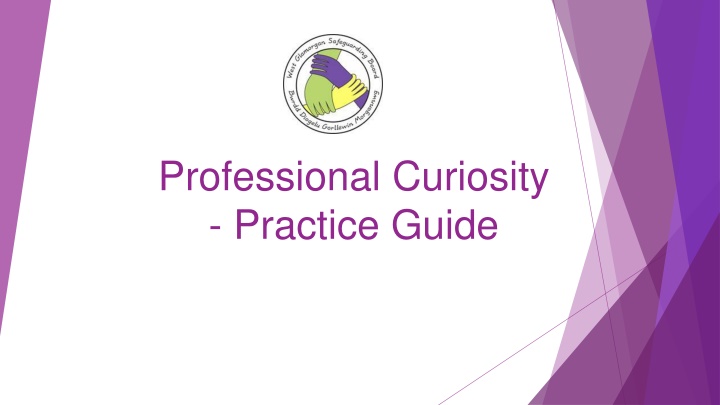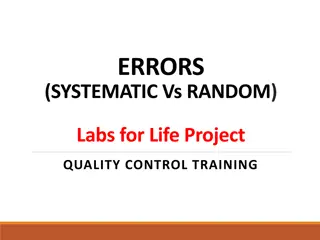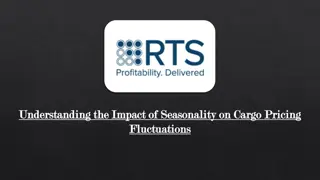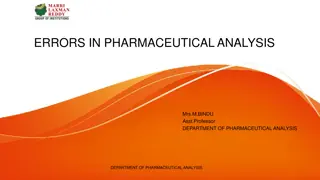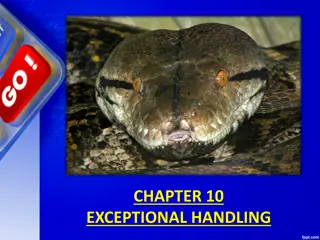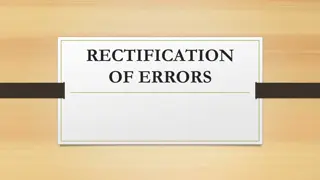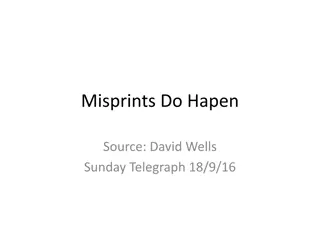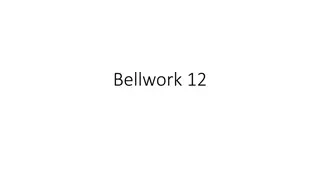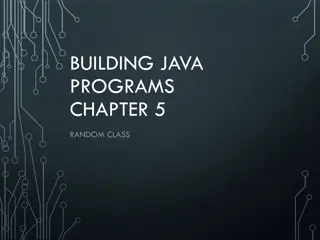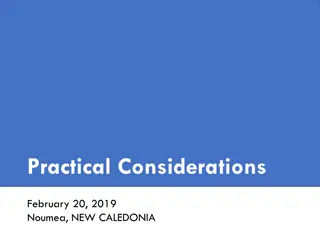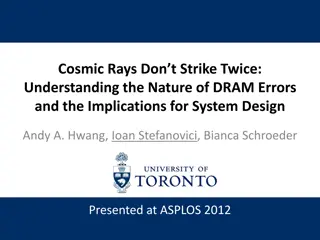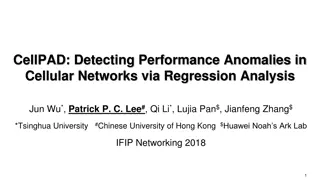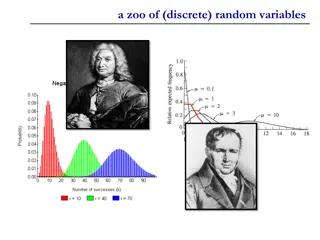Detecting Random Errors in Child Age and Its Impact on Seasonality in Child Health
This research delves into a puzzling discovery of apparent seasonality in child health outcomes, uncovering how random errors in child age could be contributing to this phenomenon. The study examines various factors and anomalies, highlighting the importance of accurate data reporting for nutrition and early childhood research in developing countries.
Download Presentation

Please find below an Image/Link to download the presentation.
The content on the website is provided AS IS for your information and personal use only. It may not be sold, licensed, or shared on other websites without obtaining consent from the author.If you encounter any issues during the download, it is possible that the publisher has removed the file from their server.
You are allowed to download the files provided on this website for personal or commercial use, subject to the condition that they are used lawfully. All files are the property of their respective owners.
The content on the website is provided AS IS for your information and personal use only. It may not be sold, licensed, or shared on other websites without obtaining consent from the author.
E N D
Presentation Transcript
Professional Curiosity - Practice Guide
What is it? All professionals who come into contact with children, parents and carers in the course of their work need to be aware of their safeguarding responsibilities and alert to the needs of vulnerable children and young people. This requires professionals to be curious and inquisitive about family circumstances and events so that they can effectively identify vulnerabilities and potential or actual risks of harm. Reviews into child deaths repeatedly highlight the need for practitioners to be alert to the risk of fixed thinking and perceptual bias. Munro (2005b) comments that repeated inquiry reports show the extraordinary lengths to which some abusive parents can go in their efforts to deceive practitioners through disguised compliance and the Daniel Pelka review emphasised the need for professionals to be able to think the unthinkable rather than accept parental versions of what is happening at home. Also described by Lord Laming (2003) in the Victoria Climbie inquiry as respectful uncertainty is the capacity to explore and understand what is happening within a family rather than making assumptions or accepting things at face value, applying critical evaluation to any information received and maintaining an open mind. By acquiring an open minded, inquiring and curious mindset, professionals can avoid linear and absolute explanations by exploring alternative, multiple perspectives on a situation.
In the national child safeguarding practice review relating to the deaths of Arthur Labinjo-Hughes and Star Hobson in 2020, several core issues were identified: There appeared to be weaknesses in information sharing between agencies Not enough critical thinking or challenge between agencies, including missed opportunities to initiate multi agency child protection processes A need for the development of more specialist child protection professionals (or teams) with skills in complex assessments of risk and understanding the behaviours of parents who do not engage with services Child protection practice should concentrate on developing leaders who enable and believe in such change by creating conditions where organisations can transform their services to undertake this complex work From Child Safeguarding Practice Review Panel, 2022, p.9 The review further highlighted once more that there was a limited amount of direct work undertaken with the families, as well as a lack of reflection and further exploration. It also mentioned how practitioner bias and assumption had impacted the way risk was assessed and how the analysis of information had been missing (NSPCC, 2022). The Child Practice Review into the tragic death of Logan Mwangi in July 2021 also identified the Covid 19 pandemic, and associated restrictions, as a barrier to identifying disguised compliance
Professional curiosity is a combination of looking, listening, asking direct questions, checking out and reflecting on information received. It means: Testing out your professional hypothesis and not making assumptions Triangulating information from different sources to gain a better understanding of individuals and family functioning Getting an understanding of individuals and families past history which in turn, may help you think about what may happen in the future Obtaining multiple sources of information and not accepting a single set of details you are given at face value Having an awareness of your own personal bias and how that affects how you see those you are working with being respectfully nosey
Why is it important? A lack of professional curiosity can lead to: missed opportunities to identify less obvious indicators of risk assumptions made in assessments for care and support and enquiries into those who may be at risk which are incorrect and lead to the wrong interventions for individuals and families Professional curiosity is supported by: A child focused approach with an ability to create suitably safe and trusting listening environment for children and young people Identifying and exploring what is not discussed as much as what is. An openness to other perspectives/ willingness to try different responses. An ability to build close partnership style relationships with families whilst being constantly aware of the child s needs/ degree to which they are met Critical thinking skills, sensitivity and persistence. Judgements based on evidence not optimism.
HOW TO REPSOND Am I remaining curious and inquisitive about what I am seeing and assessing? Am I open to new information? How confident am I that I have sufficient information upon which to base my judgements? Do I need to add a health warning about the strength of evidence contained in this assessment/ implications for decision making? Would I be prepared to change my mind? Question your own assumptions about how individuals/families function and watch out for over optimism Recognise your own feelings (for example tiredness, feeling rushed or illness) and how this might impact on your view of a child/adult/family on a given day Think about why someone may not be telling you the whole truth Demonstrate a willingness to have challenging conversations Address any professional anxiety about how hostile or resistant individual/families might react to being asked direct or difficult questions Remain open minded and expect the unexpected Appreciate that respectful uncertainty and challenge are healthy. It is good practice and ok to question what you are told Recognise when individuals/adults repeatedly do not do what they said they would and name this and discuss with them Understand the cumulative impact of multiple or combined risk factors, e.g. domestic abuse, drug/alcohol misuse, mental health, multiple missed appointments across agencies Ensure that your practice is reflective and that you have access to good quality supervision
LOOK Is there anything about what you see when you meet with this child/adult/family which prompts questions or makes you feel uneasy? Are you observing any behaviour which is indicative of harm, abuse or neglect? Does what you see support or contradict what you re being told? This might include non- verbal cues and body language. Are there other individuals involved or living in the household that you are not seeing
LISTEN LISTEN Are you being told anything which needs further clarification? Are you concerned about what you hear family members say to each other? Is someone in this family trying to tell you something but is finding it difficult to express themselves? If so, how can you help them to do so? Are you directly hearing the voice of the child or adult who may be at risk?
ASK Are there direct questions you could ask when you meet this child/adult/family which will provide more information about any risk to the individual or family? For example: - How do you spend a typical day? - How did you get that injury? - Who do you live with? - Who is this with you? - When were you last happy? - When do you feel safe/unsafe? - What do you look forward to? - Why are you not at school? Could conversational questions help you obtain further information about any risk to the individual or family? For example, tell me a bit more about that , or that sounds interesting, help me understand how that happened ?
CHECK OUT Are other professionals involved? Have other professionals seen the same as you? Are professionals being told the same or different things? Are others concerned? If so, what action has been taken so far and is there anything else which should or could be done by you or anyone else? Are all agencies sharing relevant information with each other? Are you seeing the whole picture? Links to further reading
References and further reading: Anda, R. F., Porter, L. E., & Brown, D. W. (2020) Inside the adverse childhood experience score: Strengths, limitations, and misapplications American Journal of Preventive Medicine, 59(2), 293-295 Barrett, L. F. (2017) How emotions are made: The secret life of the brain London: Pan Macmillan Barrett, L. (2020) Hypotheses about emotional development in the theory of constructed emotion: A response to developmental perspectives on how emotions are made Human Development, 64(2), 52-54 Burton, V., & Revell, L. (2018) Professional curiosity in child protection: Thinking the unthinkable in a neo-liberal world The British Journal of Social Work, 48(6), 1508-1523 Butler, A. (2021) Anger over child deaths should not trigger knee-jerk overhaul of social care policy The Guardian, 19 December 2012 (retrieved 3 March 2022) Child Safeguarding Practice Review Panel (2022) Child Protection in England: National review into the murders of Arthur Labinjo-Hughes and Star Hobson Crittenden, P. M. (2006) A dynamic maturational model of attachment Australian and New Zealand Journal of Family Therapy, 27(2), 105-115 New York, NY: WW Norton & Company
Crittenden, P. M., Landini, A., & Spieker, S. J. (2021) Staying alive: A 21st century agenda for mental health, child protection and forensic services Human Systems, 1(1), 29-51. Dickson, N. (2002) Climbi : Legacy of an inquiry BBC News (retrieved 3 July 2022) Ferguson, H. (2017) How children become invisible in child protection work: Findings from research into day-to-day social work practice The British Journal of Social Work, 47(4), 1007-1023 Griffiths S. (2018) Serious case review: Family U Norfolk Safeguarding Children Board (retrieved from NSPCC Library, 7 October 2022) Hanbury, L. (2020) ADHD or trauma: working with the potential for misdiagnosis Community Care Inform Hanbury, L. (2021) Guide to shame and recognising how it may present in children (and adults) in the child protection system Community Care Inform Hughes, D., & Golding, K. (2012)
Creating loving attachments: Parenting with PACE to nurture confidence and security in the troubled child London: Jessica Kingsley Publishers Kashdan, T., Sherman, R. A., Yarbro, J. and Funder, D. (2013) How are curious people viewed and how do they behave in social situations? From the perspectives of self, friends, parents and unacquainted observers Journal of Personality, 81(2), pp. 141 55 Main, M. (1995) Recent studies in attachment: Overview, with selected implications for clinical work . In S. Goldberg, R. Muir, & J. Kerr (Eds.), Attachment theory: Social, developmental, and clinical perspectives (pp. 407 474) Hillsdale, NJ: Analytic Press, Inc Mat , G. (2012) Addiction: Childhood trauma, stress and the biology of addiction Journal of Restorative Medicine, 1(1), 56-63 NSPCC (2022) Summary of the national review into the murders of Arthur Labinjo-Hughes and Star Hobson (CASPAR Briefing) London: NSPCC Learning Phillips, J., Ainslie, S., Fowler, A., & Westaby, C. (2022) What does professional curiosity mean to you?: an exploration of professional curiosity in probation The British Journal of Social Work, 52(1), 554-572 Thacker, H., Anka, A., & Penhale, B. (2019) Could curiosity save lives? An exploration into the value of employing professional curiosity and partnership work in safeguarding adults under the Care Act 2014
